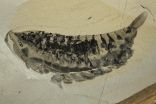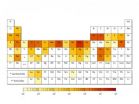(Press-News.org) Cold snaps like the ones that hit the eastern United States in the past winters are not a consequence of climate change. Scientists at ETH Zurich and the California Institute of Technology have shown that global warming actually tends to reduce temperature variability.
Repeated cold snaps led to temperatures far below freezing across the eastern United States in the past two winters. Parts of the Niagara Falls froze, and ice floes formed on Lake Michigan. Such low temperatures had become rare in recent years. Pictures of icy, snow-covered cities made their way around the world, raising the question of whether climate change could be responsible for these extreme events.
It has been argued that the amplified warming of the Arctic relative to lower latitudes in recent decades has weakened the polar jet stream, a strong wind current several kilometres high in the atmosphere driven by temperature differences between the warm tropics and cold polar regions. One hypothesis is that a weaker jet stream may become more wavy, leading to greater fluctuations in temperature in mid-latitudes. Through a wavier jet stream, it has been suggested, amplified Arctic warming may have contributed to the cold snaps that hit the eastern United States.
Temperature range will decrease
Scientists at ETH Zurich and at the California Institute of Technology, led by Tapio Schneider, professor of climate dynamics at ETH Zurich, have come to a different conclusion. They used climate simulations and theoretical arguments to show that in most places, the range of temperature fluctuations will decrease as the climate warms. So not only will cold snaps become rarer simply because the climate is warming. Additionally, their frequency will be reduced because fluctuations about the warming mean temperature also become smaller, the scientists wrote in the latest issue of the Journal of Climate.
The study's point of departure was that higher latitudes are indeed warming faster than lower ones, which means that the temperature difference between the equator and the poles is decreasing. Imagine for a moment that this temperature difference no longer exists. This would mean that air masses would have the same temperature, regardless of whether they flow from the south or north. In theory there would no longer be any temperature variability. Such an extreme scenario will not occur, but it illustrates the scientists' theoretical approach.
Extremes will become rarer
Using a highly simplified climate model, they examined various climate scenarios to verify their theory. It showed that the temperature variability in mid-latitudes indeed decreases as the temperature difference between the poles and the equator diminishes. Climate model simulations by the Intergovernmental Panel on Climate Change (IPCC) showed similar results: as the climate warms, temperature differences in mid-latitudes decrease, and so does temperature variability, especially in winter.
Temperature extremes will therefore become rarer as this variability is reduced. But this does not mean there will be no temperature extremes in the future. "Despite lower temperature variance, there will be more extreme warm periods in the future because the Earth is warming," says Schneider. The researchers limited their work to temperature trends. Other extreme events, such as storms with heavy rain or snowfall, can still become more common as the climate warms, as other studies have shown.
North-south shift makes the difference
And the jet stream? Schneider shrugs off the idea: "The waviness of the jet stream that makes our day-to-day weather does not change much." Changes in the north-south difference in temperatures play a greater role in modifying temperature variability.
Schneider wants to explore the implications these results have in further studies. In particular, he wants to pursue the question of whether heatwaves in Europe may become more common because the frequency of blocking highs may increase. And he wants to find why these high pressure systems become stationary and how they change with the climate.
INFORMATION:
University of Notre Dame applied mathematician Mark Alber and environmental biotechnologist Robert Nerenberg have developed a new computational model that effectively simulates the mechanical behavior of biofilms. Their model may lead to new strategies for studying a range of issues from blood clots to waste treatment systems.
"Blood clotting is a leading cause of death in the United States at this point," said Alber, who is The Vincent J. Duncan Family Professor of Applied Mathematics in the College of Science and an adjunct professor of medicine at the Indiana University ...
TEMPE, Ariz. (March 27, 2015) - As more people move to different regions of the country it will require planners to use as many tools as they can to develop urban areas that satisfy population demands and not over burden the environment.
A new study from Arizona State University (ASU) details some of the dynamics at play as one region of the country, the Central Valley of California, braces for substantial population growth and all it entails. The study, based on computer simulations using the ASU Advanced Computing Center, of rural to urban land conversion shows that ...
March 27, 2015--A study by researchers at Columbia University's Mailman School of Public Health and colleagues in the Netherlands evaluated the relationship between nutritional conditions in very early life and adult health, and found that famine exposure during the first pregnancy trimester was associated with increases in mortality from a variety of causes other than cancer or cardiovascular disease.
This is the first study to quantify the possible long-term effects of nutrition deprivation at different stages of pregnancy and long-term mortality from causes of death ...
BUFFALO, N.Y. - A big bowl of mashed potatoes. What about spaghetti and meatballs? Sushi? Regardless of what you identify as comfort food, it's likely the attraction to that dish is based on having a good relationship with the person you remember first preparing it, according to the results of a new study by a University at Buffalo research team.
The findings have implications for better understanding how social factors influence our food preferences and eating behavior.
"Comfort foods are often the foods that our caregivers gave us when we were children. As long we ...
Milan, Italy - March 28, 2015 Research looking at risk of early mortality of British middle-aged women and osteoarthritis was presented today at the World Congress on Osteoporosis, Osteoarthritis and Musculoskeletal Diseases. It shows that any painful knee osteoarthritis is strongly associated with early overall and cardiovascular mortality. Interestingly these findings are independent to most of the known risk factors linked with early mortality. The study was based on the data from the Chingford Study. This is community based data from a cohort of middle-aged women followed ...
TORONTO, ON - What do butterflies, spiders and lobsters have in common? They are all surviving relatives of a newly identified species called Yawunik kootenayi, a marine creature with two pairs of eyes and prominent grasping appendages that lived as much as 508 million years ago - more than 250 million years before the first dinosaur.
The fossil was identified by an international team led by palaeontologists at the University of Toronto (U of T) and the Royal Ontario Museum (ROM) in Toronto, as well as Pomona College in California. It is the first new species to be described ...
Reclusive giant pandas fascinate the world, yet precious little is known about how they spend their time in the Chinese bamboo forests. Until now.
A team of Michigan State University (MSU) researchers who have been electronically stalking five pandas in the wild, courtesy of rare GPS collars, have finished crunching months of data and has published some panda surprises in this month's Journal of Mammalogy.
"Pandas are such an elusive species and it's very hard to observe them in wild, so we haven't had a good picture of where they are from one day to the next," said ...
Music performance is known to induce structural and functional changes to the human brain and enhance cognition. However, the molecular mechanisms underlying music performance have been so far unexplored. A Finnish research group has now investigated the effect of music performance (in a 2 hr concert) on the gene expression profiles of professional musicians from Tapiola Sinfonietta (a professional orchestra) and Sibelius-Academy (a music university).
Playing music enhanced the activity of genes involved in dopaminergic neurotransmission, motor function, learning and ...
In a new paper, a team of Yale researchers assesses the "criticality" of all 62 metals on the Periodic Table of Elements, providing key insights into which materials might become more difficult to find in the coming decades, which ones will exact the highest environmental costs -- and which ones simply cannot be replaced as components of vital technologies.
During the past decade, sporadic shortages of metals needed to create a wide range of high-tech products have inspired attempts to quantify the criticality of these materials, defined by the relative importance of ...
A new study from SciLifeLab at Uppsala University published in PLOS ONE shows that genes crucial for vision were multiplied in the early stages of vertebrate evolution and acquired distinct functions leading to the sophisticated mechanisms of vertebrate eyes.
One striking feature of vertebrates is the prominent role that vision plays in almost all major animal groups. The vertebrate eye has a unique organization and is known to have arisen at the time of the first vertebrates over 500 million years ago. A new study by the research team led by Xesús Abalo and Dan ...


